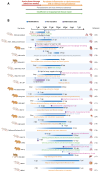Animal models of post-acute COVID-19 syndrome: a call for longitudinal animal studies
- PMID: 40079013
- PMCID: PMC11897041
- DOI: 10.3389/fimmu.2025.1521029
Animal models of post-acute COVID-19 syndrome: a call for longitudinal animal studies
Abstract
Animal models are indispensable for unraveling the mechanisms underlying post-acute sequelae of COVID-19 (PASC). This review evaluates recent research on PASC-related perturbations in animal models, drawing comparisons with clinical findings. Despite the limited number of studies on post-COVID conditions, particularly those extending beyond three months, these studies provide valuable insights. Three hallmark features of PASC-lung fibrosis, hyperglycemia, and neurological sequelae-have been successfully replicated in animal models, paving the way for mechanistic discoveries and future medical interventions. Although most studies have reported post-COVID conditions within 14-60 days post-infection, they still offer critical reference for future long-term research. This review also explores potential mechanisms of persisting immune misfiring, a key factor in the chronicity of PASC symptoms. Moreover, challenges in modeling PASC are also discussed, including the limited genetic diversity in inbred animal strains and difficulties in accurately identifying PASC-affected individuals. To address these issues, we propose methodological improvements, such as comparing individual animal parameters with control averages and incorporating genetically diverse populations like collaborative cross models. These strategies will enhance the identification and characterization of PASC endotypes in animal studies. By integrating findings from animal models with clinical manifestations of PASC, future research can provide more valuable insights into its mechanisms and support the development of effective therapeutic strategies. Finally, we emphasize the urgent need for longitudinal studies in animal models to fully uncover the mechanisms driving PASC and guide interventions to mitigate its public health impact.
Keywords: animal models; immune tolerance; long-term perturbations post coronavirus infection; organ manifestations; post-acute COVID-19 syndrome.
Copyright © 2025 Dai, He, Chen, Li, Zhao and Du.
Conflict of interest statement
The authors declare that the research was conducted in the absence of any commercial or financial relationships that could be construed as a potential conflict of interest.
Figures

Similar articles
-
A longitudinal SARS-CoV-2 biorepository for COVID-19 survivors with and without post-acute sequelae.BMC Infect Dis. 2021 Jul 13;21(1):677. doi: 10.1186/s12879-021-06359-2. BMC Infect Dis. 2021. PMID: 34256735 Free PMC article.
-
The Neurological Manifestations of Post-Acute Sequelae of SARS-CoV-2 infection.Curr Neurol Neurosci Rep. 2021 Jun 28;21(9):44. doi: 10.1007/s11910-021-01130-1. Curr Neurol Neurosci Rep. 2021. PMID: 34181102 Free PMC article. Review.
-
Pathogenic mechanisms of post-acute sequelae of SARS-CoV-2 infection (PASC).Elife. 2023 Mar 22;12:e86002. doi: 10.7554/eLife.86002. Elife. 2023. PMID: 36947108 Free PMC article. Review.
-
Animal Models of Non-Respiratory, Post-Acute Sequelae of COVID-19.Viruses. 2025 Jan 14;17(1):98. doi: 10.3390/v17010098. Viruses. 2025. PMID: 39861887 Free PMC article. Review.
-
A Disease Hidden in Plain Sight: Pathways and Mechanisms of Neurological Complications of Post-acute Sequelae of COVID-19 (NC-PASC).Mol Neurobiol. 2025 Feb;62(2):2530-2547. doi: 10.1007/s12035-024-04421-z. Epub 2024 Aug 12. Mol Neurobiol. 2025. PMID: 39133434 Review.
Cited by
-
Spatiotemporal Characterization of Changes in the Respiratory Tract and the Nervous System, Including the Eyes in SARS-CoV-2-Infected K18-hACE2 Mice.Viruses. 2025 Jul 9;17(7):963. doi: 10.3390/v17070963. Viruses. 2025. PMID: 40733579 Free PMC article.
References
Publication types
MeSH terms
LinkOut - more resources
Full Text Sources
Medical
Miscellaneous

